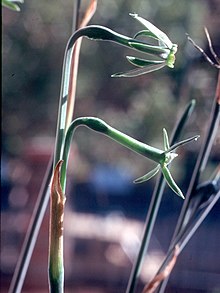You can help expand this article with text translated from the corresponding article in Spanish. (November 2014) Click for important translation instructions.
|
| Narcissus viridiflorus | |
|---|---|

| |
| Conservation status | |
 Near Threatened (IUCN 3.1) | |
| Scientific classification | |
| Kingdom: | Plantae |
| Clade: | Tracheophytes |
| Clade: | Angiosperms |
| Clade: | Monocots |
| Order: | Asparagales |
| Family: | Amaryllidaceae |
| Subfamily: | Amaryllidoideae |
| Genus: | Narcissus |
| Species: | N. viridiflorus |
| Binomial name | |
| Narcissus viridiflorus Schousb. | |
| Synonyms | |
| |
Narcissus viridiflorus, commonly known as campanitas, is a species of the genus Narcissus (daffodils) in the family Amaryllidaceae. It is classified in Section Jonquillae.
Description
Narcissus viridiflorus possesses a number of unusual features for the genus Narcissus. It is the only species with green flowers, it flowers at night and is one of only five Narcissus species that bloom in the Autumn, rather than Spring.
Taxonomy
Danish botanist Peter Schousboe described the species in 1800 from material collected in Morocco. The species name is derived from the Latin words viridis "green" and flos/floris "flower".
Distribution
Narcissus viridiflorus is native to the southern Iberian Peninsula (southern Spain) and North Africa (northern Morocco). It is known from fewer than 15 populations, with a total area of 84 square kilometres, and is threatened by overgrazing and urban development. It has not been well-studied in north Africa and there may be more populations there.
References
- ^ Rankou, H.; Chambouleyron, M. (2018). "Narcissus viridiflorus". IUCN Red List of Threatened Species. 2018: e.T162196A20176054. doi:10.2305/IUCN.UK.2018-1.RLTS.T162196A20176054.en. Retrieved 11 November 2021.
- The Plant List
- Iagttag. Vextrig. Marokko 157 1800.
| Taxon identifiers | |
|---|---|
| Narcissus viridiflorus |
|
This Amaryllidaceae article is a stub. You can help Misplaced Pages by expanding it. |